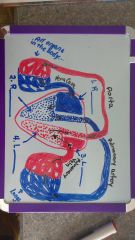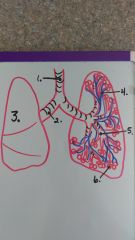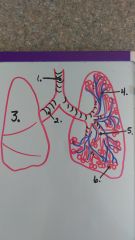![]()
![]()
![]()
Use LEFT and RIGHT arrow keys to navigate between flashcards;
Use UP and DOWN arrow keys to flip the card;
H to show hint;
A reads text to speech;
38 Cards in this Set
- Front
- Back
|
What parts/organs make up the circulatory system?
|
The heart and blood vessels make up the circulatory system.
|
|
|
What organ makes up the respiratory system?
|
The lungs make up the respiratory system.
|
|
|
What are the 3 basic kinds of blood vessels?
|
1. Veins 2. Arteries 3. Capillaries |
|
|
Define veins...
|
Blood vessels that carry blood back to the heart. This blood is usually (but not always) deoxygenated.
|
|
|
Define arteries...
|
Blood vessels that carry blood away from the heart to the rest of the body. This blood is usually oxygenated.
|
|
|
Name the arteries and veins that take blood to the heart from the lungs and from the heart to the lungs...
|
Pulmonary veins (from lungs to heart) and pulmonary arteries (from heart to lungs).
|
|
|
Name the main artery that takes blood from the heart to the rest of the body...
|
The aorta is the main artery.
|
|
|
Name the main veins that transport blood from the rest of the body back to the heart (there are 2)...
|
The superior and inferior vena cava are the 2 main veins.
|
|
|
Define capillaries...
|
Capillaries are tiny thin-walled vessels that allow the exchange of nutrients and gases for the body AND connect arteries to veins.
|
|

Starting with the vena cava, identify the 4 chambers of the heart in order that the blood flows through...
|
1. Right Atrium 2. Right Ventricle 3. Left Atrium 4. Left Ventricle |
|
|
Which chamber of the heart receives deoxygenated blood from the body?
|
The right atrium receives deoxygenated blood from the body.
|
|
|
Which chamber of the heart pumps blood into the pulmonary artery to the lungs?
|
The right ventricle pumps blood to the lungs.
|
|
|
Which chamber of the heart receives blood from the lungs through the pulmonary vein?
|
The left atrium receives blood from the lungs.
|
|
|
Which chamber of the heart pumps oxygenated blood to the rest of the body?
|
The left ventricle pumps blood to the rest of the body.
|
|
|
Name the 4 main components of blood...
|
1. Red blood cells 2. White blood cells 3. Platelets 4. Plasma |
|
|
What is the liquid that makes up more than half our blood, and contains nutrients and cells?
|
Plasma makes up more than half our blood.
|
|
|
Which cells in the blood carry oxygen and a red protein called hemoglobin?
|
Red blood cells carry oxygen and hemoglobin.
|
|
|
Which cells in the blood protect our bodies by fighting disease with chemical antibodies?
|
White blood cells fight disease.
|
|
|
Which blood cells aid clotting so that you don't bleed to death?
|
Platelets aid in clotting blood.
|
|
|
Where are your blood cells produced?
|
Blood cells are produced in your bone marrow.
|
|
|
What does 'clotting' mean? What does it do for your body?
|
Clotting is the way your body seals off a damaged blood vessel to prevent you from bleeding to death while the injury heals.
|
|

Identify parts 1, 2, and 3 of the lungs: (alveoli, artery, bronchial tube, bronchioles, lung, trachea)
|
1. trachea 2. bronchial tube 3. lung |
|

Identify parts 4, 5, and 6 of the lungs: (alveoli, artery, bronchial tube, bronchioles, lung, trachea)
|
4. artery (takes blood from the heart) 5. bronchioles 6. alveoli sacs |
|
|
How many alveoli does the average adult have in their lungs?
|
30,000,000
|
|
|
Where does most of the oxygen exchange take place in our lungs?
|
Most of the oxygen exchange takes place in the alveoli, which are covered with capillaries.
|
|
|
Which of your lungs is smaller, and why?
|
The left is smaller to make room for the heart.
|
|
|
After the air leaves your lungs when you exhale, where does it go?
|
Into the trachea, through the larynx (voice box), through the pharynx (throat), and out (either your nose or mouth).
|
|
|
What is the name of the muscle that forces air in and out of your lungs?
|
The diaphragm.
|
|
|
How do you change the volume (loudness) of your vocal cords? The pitch (high/low)?
|
More air makes you louder. Tighter cords make you higher pitched.
|
|
|
What organs do fish have to extract and convert oxygen?
|
Gills
|
|
|
What do you call the "blood vessels" in a plant that carry water from the roots to the rest of the plant?
|
xylem
|
|
|
What do you call the 'blood vessels' in plants that carry food from the leaves to the rest of the plant?
|
Food flows through phloem.
|
|
|
What is the purpose of your lungs?
|
Your lungs oxygenate your blood and remove CO2.
|
|
|
What is the purpose of your heart?
|
It pumps blood throughout your body.
|
|
|
What system of the body includes the heart and blood vessels?
|
The circulatory system.
|
|
|
What system of the body includes the lungs, trachea, bronchial tubes and alveoli?
|
The respiratory system.
|
|
|
Where are your bronchial tubes and what travels through them?
|
They are found in your lungs. Air travels through them.
|
|
|
Where are your vocal cords found?
|
Vocal cords are in the larynx.
|

